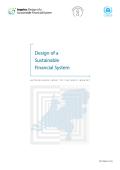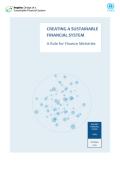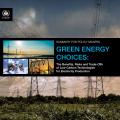This study seeks to provide new perspectives and proposals on the relationship between institutional investors and sustainable development in the context of a more sustainable financial system. The report’s key messages advocate for systemic and dynamic policy reform that better aligns institutional investors with policy goals for sustainable development. Seven critical policy objectives that hold the strongest potential for positive change are explored in the report together with fourteen policy tools to get us there.
The paper presents a theoretical model of a different and more sustainable role for financial agents and markets that is justified by systematic philosophical arguments and reasoning. It is normative rather than descriptive, and does not review how the financial system currently functions, but rather how it ought to function in the future. The goal is to identify a new direction for finance which the majority of commentators will recognize as both desirable and achievable.
Fiscal considerations may shift governmental priorities away from environmental concerns: finance ministers face strong demand for public expenditures such as infrastructure investments but they are constrained by international tax competition. We develop a multi-region model of tax competition and resource extraction to assess the fiscal incentive of imposing a tax on carbon rather than on capital. We explicitly model international capital and resource markets, as well as intertemporal capital accumulation and resource extraction. While fossil resources give rise to scarcity rents, capital does not. With carbon taxes, the rents can be captured and invested in infrastructure, which leads to higher welfare than under capital taxation. This result holds even without modeling environmental damages. It is robust under a variation of the behavioral assumptions of resource importers to coordinate their actions, and a resource exporter’s ability to counteract carbon policies. Further, no green paradox occurs—instead, the carbon tax constitutes a viable green policy, since it postpones extraction and reduces cumulative emissions.

This note summarizes the input provided to the UNEP Inquiry at a meeting with representatives from the Dutch financial sector ranging from public policymakers and regulators to the largest banks, asset managers, insurance companies and sustainable frontrunners. The policy recommendations include best practices, financial market policy and regulatory innovations to help bring about the green economy and a sustainable financial sector.

This paper investigates various roles that finance ministries can assume to promote those policies, regulations and standards which help to create a sustainable financial system. Finance ministries typically interact with the financial sector in many ways, from regulator and supervisory mandate setters to tax authority and sovereign debt issuers. All of these points of leverage empower them to play a key role in making financial systems sustainable.
Sustainability is not often regarded to be part of a finance ministry’s policy mandate. Therefore, this paper looks at cases where finance ministries use their mandates to bring about innovation in the space: Uganda, the Netherlands, the UK, South Africa, France and Germany. In conclusion, under the current mandates of finance ministries, much has already been done to begin creating significant openings that stimulate sustainability in the financial sector.
This report, led by the International Finance Corporation and the UNEP Inquiry into the Design of a Sustainable Financial System, aims to promote inclusive green investment in Kenya. It focuses on policy, structural, and investment innovations across the economy and financial sector that would increase capital flows that support sustainable development.
It looks at the main barriers to inclusive green investment and suggests options to promote inclusive green investment in Kenya, which include: developing cohesive, market-wide policy and regulation; effective enforcement of the market-led Sustainable Finance Principles in the banking; consolidating the pension and insurance sectors; providing structured market support to develop institutional investment vehicles; addressing gaps in existing environmental and social regulation; aligning foreign direct investment (FDI) objectives with the green growth agenda.
During the 2008 financial crisis, central banks deployed unconventional means to rescue failing banks and insulate economies from depression. Their asset purchases have had strong social impacts, but traditionally, central banks have not explicitly factored social objectives into their decisions or evaluated their impacts beyond the narrow monetary domain.
In this paper Andrew Sheng argues that central banks, when purchasing financial assets, should consider selecting assets that will promote sustainability, including climate change mitigation and adaptation. Social impact investing he argues is consistent with a central bank’s mandate to maintain price stability. They could incentivize bankers and asset managers to invest in, or lend to, climate mitigation activities and low-emission growth.
An efficient and resilient regulatory regime must not only deal competently with the financial system that exists currently; it must also have adaptive capacity to deal competently with the system that is emerging.
This working paper examines disruptive innovations and their implications for the design of a green and inclusive financial system. It identifes five trends relevant to the design of a green and inclusive financial system:
1- disintermediation of capital and payments – such as crowdfunding, peer to peer payments and mobile money;
2- new forms of credit creation – such as digital currencies, local currencies and closed loop credit clearance systems;
3- long-term environmental and social impacts – such as the impact of resource constraints, climate impacts, falling labour productivity, stagnating real wages, demographic change on pensions and insurance;
4- technological innovation – such as big data and the ‘internet of things’.

Rising energy demand and efforts to address climate change require a significant increase in low-carbon electricity generation. Yet, concern has been raised that rapid investment in some novel technologies could cause a new set of environmental problems.
This is a summary of the key findings of the International Resource Panel (IRP) report Green Energy Choices: The Benefits, Risks and Trade-Offs of Low-Carbon Technologies for Electricity Production which aims to support policy-makers in making choices about the technologies, infrastructures and energy sources. It does so through an analysis of the mainstream commercially available renewable and non-renewable power generation technologies3, analysing their GHG mitigation potential, but also tradeoffs in terms of: Environmental impacts (impacts on ecosystems, eutrophication and acidification, etc.) Human health impacts (particulates and toxicity) Resource use implications (iron, copper, aluminium, cement, energy, water and land).
Although there is progress in developing green sectors in some countries, the key challenge facing the expansion of economy-wide green innovation and structural change is the absence of relevant policy follow-up to the green stimulus enacted during the Great Recession. The boost to green sectors provided by such measures is waning quickly, given that much of the green stimulus focused on energy efficiency. The biggest obstacles to sustaining green growth are major market disincentives, especially the underpricing of fossil fuels and market failures to spur green innovation. A three-part strategy to overcome these obstacles would involve, first, removing fossil fuel subsidies, second, employing market-based instruments to further reduce the social costs of fossil fuel use, and third, allocating any resulting revenue to public support for green innovation and investments. Such a strategy would ensure that green growth is not about promoting niche green sectors but instigating economy-wide innovation and structural transformation.
